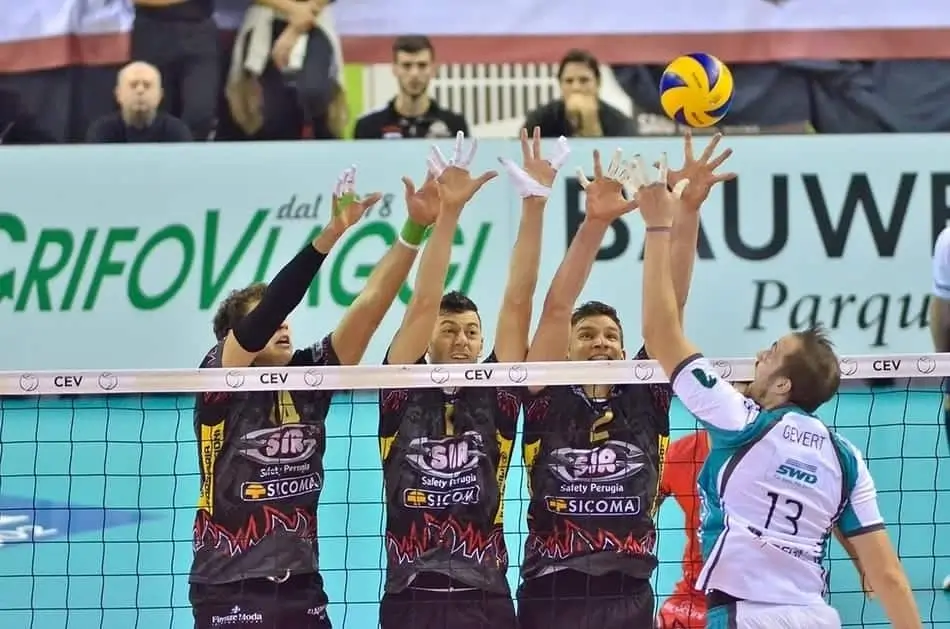Last Updated: November 21, 2023
As an individual volleyball player, you will feel super excited and motivated when you excel in blocking. That’s fine since such moments can help boost your self-esteem for an outstanding performance in the next competition.
But the truth is success only comes when you coordinate and combine forces with your teammates to conquer the court.
So, what’s the power of teamwork in blocking? This article explains deeply how your team can sync up and shut down your opponents for better defense.
Players should know their roles and positions and how to interpret the opponent’s intentions for perfect blocking. That’s not all, communication between the blockers and defense players is vital to prevent unwanted errors.
Why is Teamwork Important in Volleyball?

A team can’t achieve a win in volleyball without loyalty and hard work from all the players. A player should know when to play the ball alone or pass it to another player. Practice regularly with your fellow players to improve your skills.
Teamwork teaches volleyball players to be disciplined, respectful, enhances communication, and helps them overcome challenges.
Volleyball Blocking Drills for Perfect Timing
Although reasonable ball control and passing are vital for the team’s defense, delivering a successful block is the best way to slow or stop an attack. A successful block requires proper timing though. That’s why you should perform drills centered on your ability to interpret plays and improve your reaction time.
The following drills incorporate blocking and other roles of your fellow players for team improvement.
1. Cover the Net
This drill tests the blocker’s decision-making nature when faced with a free ball. The blocker has three options: block it, set it, or kill it. There are 3 blockers on one side of the net and a chosen player or coach on the other after the 3-meter line. The person tossing the ball should have sufficient balls to make repeat tosses.
The player or coach who tosses the ball should shout “free ball” and then toss it to a specific blocker over the net. A blocker then decides whether to block the ball, attack it, or set it back to defenders to run an offense. For better efficiency, a blocker should practice all three scenarios; this can be supported by the person tossing the ball.
2. Block, Reset, Fall Back
This drill aims to test blocker honesty in covering their assigned area whenever a ball is tossed. Surprisingly, the player may block only a few balls as many will pass the blocker and hit the ground. This happens because the blocker isn’t alert and is still at the net and unaware of the ball. The drill involves 1 player or coach standing on a box on one side and 1 blocker at the net.
There should be an extra person who hands the person at the box the balls. The coach on the box should hold the ball slightly above the net height. Immediately after the signal, the blocker should jump up and touch the ball as if to block. The coach then drops the ball down directly to the blocker or tosses it to the space behind the blocker
3. Watch the Hitter / Blind-Blocking Drill
For this method, a player behind the blocker tosses the ball to a hitter on the opposite court. The hitter attacks the ball as previously set, while the blocker tracks the hitter and makes an appropriate block. The purpose is to eliminate the blocker’s mentality of “ball watching” but instead track a hitter’s movements and intentions.
4. Don’t Fear the Seam
This drill tests a team’s backcourt defense and blocking techniques. Set up two teams for six-on-six volleyball play. The ball is sent as an attack on one team. An outside blocker tandem blocks the ball with the middle blocker by going straight up with their hands. The suitable defense player should read the seam and try to dig the ball; this is where the drill stops.
5. Triple Block Exhaustion
Two teams play six-on-six set-up and must initiate the play with a free ball instead of a serve. While the teams are competing, the defensive players of each side should perform a triple block to counter any attack they get. This drill tests the players’ quick decision-making ability and coordination with teammates.
6. Block and Smash Drill
There are two players: one blocking and another attacking. The blocker stands near the net but between the target mat and the hitter. The hitter throws the ball towards the net to start the drill and sets it back. The hitter moves to the ball to make an attack hit focused on the target mat. Therefore, the blocker task is to block and smash the coming ball so it won’t hit the target mat.
See other defensive drills to improve your volleyball game
Essential Blocking Strategies in Volleyball
There are many blocking techniques and strategies for improving your team’s defense. Let me highlight the essential ones that will help you become a pro blocker.
Proper Body Positioning
As the game develops on your opponent’s side, be defensive by positioning your feet apart to match your shoulder width. Bend your knees forward slightly and place yotur hands in a manner that doesn’t leave a hole in between for the ball to pass.
Build more strength to block the ball by opening your palms and spreading your fingers wide. Ensure your shoulders and hips are facing the net.
Read more: Body Positioning Tips to Practice Blocking
Stay Alert
Don’t let an attack get you off guard. Instead, prepare to block and be defensive while observing your opponent’s player’s movements. Apart from being physically ready, you should be mentally alert and believe you will make a successful block.
Also, know where all your team’s players are, as some ball situations may force you to perform a triple block with the defenders.
Read your Attacker
Your opponent’s hitter makes the attack and can only move after the ball is set. So, once the setter sets a ball to the hitter, a blocker should immediately shift focus to the hitter.
Observe how your attacker moves their shoulders and arms to predict the possible direction the ball will take when hit. Additionally, evaluating other factors like whether the opponent is tall or short and the distance of the attacker from the net are equally important.
Teamwork and Communication
Effective communication between players, not just in blocking, helps them avoid many errors on the court, which can even lead to accidents.
For example, two blockers attempting to block simultaneously may collide and possibly have a hard time resisting the opponent’s team’s attack. Therefore, the blockers should signal each other on who will resist the attack early enough.
Time your Jump
Synchronize your jump with your opponent’s arm swing as they jump to hit the ball. This helps you to be just in time to block the ball as it crosses over the net. Please don’t make the mistake of jumping too early (at the same time your opponent jumps), as you will reach your highest point before the ball, thus increasing your chances of losing it. Practicing proper footwork patterns will also help you to make a better jump.
Analyze your Attacker’s Weak Points
Quickly identify your attacker’s weakness as the play develops. You can also communicate the information you gathered to your fellow blockers to build a better defense.
Know that the opposing team is also analyzing your weakness to get a soft landing place. If you realize this, change tactics and blocking strategy to surprise the opponent and leave him guessing your next move.
Conclusion
To be a successful blocker, you should position yourself correctly, jump perfectly, stay alert, and communicate well with other players. Practicing how to cover the net, having a good court vision, and examining your attackers’ weak points are also essential strategies. Always seek feedback from your teammates or coach on your performance and improvement areas.
You can’t underestimate the power of teamwork in blocking, as it can help build a good defense strategy, which is great for earning extra points. Perform blocking drills regularly to improve a blocker’s confidence and mastery. Your capability to frustrate and eventually shut down your opponents’ attacks requires both individual player effort and teamwork.
